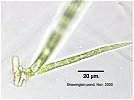

Identify that alga:
Web-based key to genera -3: branched filaments with chloroplasts
Algal Search Sitemap and quick links |
|||||||
Jump to: (filename) |
unbranched cyanobacteria (search5) |
branched cyanobacteria (search6) |
|||||
attached, flat plate (search13) |
|||||||
Colonies and coenobia : Cyanobacteria (search21) |
|||||||
Unicells (under development) |
non-flagellate cells without case (under development) |
in silica case = diatoms (under development) |
flagellate cells (under development) |
||||
no chloroplast: |
|||||||
Click on the underlined text link to jump to the next step:
| Branched filaments | Click on the thumbnail for a larger image | |||
|

 |
|||
|

 |
|||
|
True Branching |
||||
|
||||
|
  |
|||
|
||||
|
||||
|
Draparnaldia: If branch-bearing cells are shorter, it is Draparnaldiopsis |
|||
|
||||
|

Batrachospermum: (Rhodophyta) "frog-spawn alga" |
|||
|
||||
|
||||
|
|

 Enteromorpha:
more
commonly known as a marine species
Enteromorpha:
more
commonly known as a marine species |
|||
|

 Lemanea: a Rhodophyte |
|||
|

 Asterocystis (Chroodactylon): Rhodophyte |
|||
|
 Stigonema
Stigonema
 Hapalosiphon
Hapalosiphon
|
|||
|
||||
|
 Audouinella |
|||
|
 Cladophora |
|||
|
 Heterococcus |
|||
|
Coleochaete: other species are pseudoparenchymatous (forming a flat disc) |
|||
|
["Hair" refers to a cellular or multicellular extension to a filament: "bristle", "seta" and "pseudocilium" are non-cellular] | |||
|
 Stigeoclonium: this actually has 2 filament types, erect and prostrate (which attaches it to the substratum, but is not usually collected in field specimens) |
|||
|

Aphanochaete: |
|||
| Branching repeated, with ends of filaments bearing pointed cells or drawn into long multicellular hairs: the whole colony contained in a firm, dense mucilage. | 
 Chaetophora |
|||
|
||||
|

Palmodictyon |
|||
John Kinross